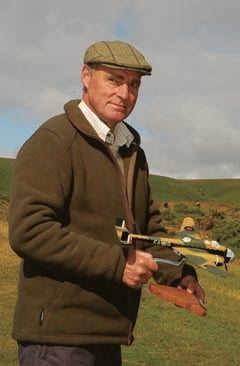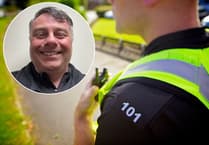A MEMORIAL to the second world war RAF crew who died on Dartmoor when their bomber aircraft crashed has been restored. Tragedy struck at Hamel Down late on March 21, 1941, when the four men flying with 49 Squadron were returning to Scampton, Lincolnshire. They had been on a raid, targeting a German U-boat base in Lorient, Brittany. Having successfully completed their perilous mission, which involved three circuits of the heavily defended target, the crew headed back for England, only to meet with a terrible end on the moors. With low cloud, pitch black conditions and orders to avoid Plymouth airspace to contend with, their Handley Page Hampden failed to clear the Hamel Down ridge north of Widecombe and ploughed into the ground at perhaps 200mph. The fuselage broke up and an intense fire followed. Three of the men were killed at the scene but the captain, his cockpit having been thrown some 100 yards clear, died the following day. Former RAF pilot Lohn Lowe from Sidmouth has made it a personal mission to unravel exactly what happened that fateful night. With a forensic eye for detail he has studied every aspect of the flight and met at least one person who was there. Explaining why the Hampden had strayed from a safe path he said: 'The best academic guess you can get is disorientation over target, minute variations of compass bearings at that point magnified over their return journey. 'They had an option to descend and try to find a coastal landmark they could pinpoint. The navigator, on his first-ever operational mission, was unable to take any sightings for wind drift or rotation. 'They decided for some reason to come down to 1,500ft — an altitude known as suicide height — and when the navigator thought they had been on that track for long enough they then decided to go back to a safer altitude. 'I believe at that point they impacted Hamel Down.' Those who died at the scene were second pilot and navigator Richard Leonard Ashburton Ellis from South Africa, gunner Charles John Lyon and wireless operator Ronald Brames. The pilot, the Hon Robert David Wilson, was found barely alive but positioned as if still clutching the aircraft's controls. He was operated on by Maj Blackburn at Moretonhampstead Hospital — on standby, it being the second night of the Plymouth Blitz — but within 22 hours he too was dead. Both he and Sgt Ellis now lie at Exeter Higher Cemetery, their colleague Sgt Lyon in Liverpool and Sgt Brames in London. They were aged between 22 and 25. The pilot's mother, Lady Marjorie, had a stone erected at the site where it is believed the cockpit came to a rest. It bears the men's initials, a cross, their squadron details and date of the crash. Now badly weathered, mason Andy Cribbett has re-cut the inscription as part of the Dartmoor National Park Authority's Moor Than Meets The Eye project. A plaque set on the memorial's southern face by the Aircrew Association in 1991 remains perfectly legible but contains an error. It suggests the Hampden crashed on March 22, actually the date Capt Wilson died. Further research is planned for the near future, most notably a geophysical survey that could identify exactly where the aircraft made contact with the ground and the precise spot where the cockpit lay. The results could settle the debate as to whether Capt Wilson was trying to effect a forced landing, as Mr Lowe believes. 'It was the human element that prompted us to do all this,' he said. 'If we can find that spot that will bring closure.'

fFormer RAF pilot John Lowe. Picture by Nigel Canham
Comments
This article has no comments yet. Be the first to leave a comment.



